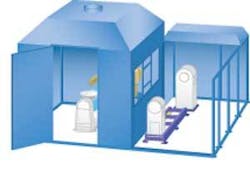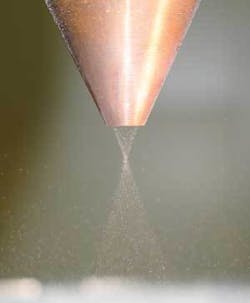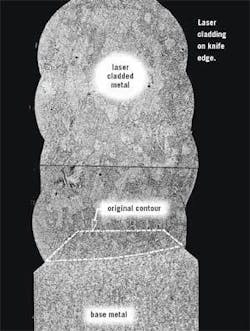Repairing aero-engine parts
Martien H. H. Van Dijk
Laser cladding proves to be a cost-effective alternative to dabber welding
Despite some dramatic accidents that get the full attention of the media, flying is still by far the safest means of transport with the lowest number of causalities per passenger kilometer. Safety regulations for airframes and aero engines are very tight. The efforts needed to comply with these regulations have a significant impact on the cost structure of airline companies. And computation is high, and therefore airliners are looking for opportunities that may help to reduces costs while still complying with safety regulations.
One cost factor is aero-engine overhaul. Parts worn out during service need to be replaced. The prices of spare parts for aero engines are high, so in many cases repair of parts is cost effective. However the quality of a repaired part must meet high safety conditions. One well-accepted repair method is dabber welding. This is a TIG welding process used to rebuild worn-out surfaces. The filler material may be added as wire or as powder. In many cases the power supply is pulsed to reduce the heat input in the process.
The cost of refurbishing components depends not only on the welding process itself but also on the pre- and post-processing steps. Preprocessing includes removal of coating, cleaning, and machining to remove the damaged area. Post processing includes machining to specified dimensions and coating. The need for machining of welded surfaces depends strongly on the quality of the welding process. The process of refurbishing is further complicated by the fact that the parts are deformed during operation.
Despite the measures taken to reduce the heat input and to reduce the track width, dabber welding still has its limitations in application and in welding narrow tracks, resulting in extensive post weld machining. Laser welding heat input is lower and weld tracks can be much smaller. The engine overhaul shop of a European airliner decided to replace dabber welding with laser cladding.
The first step was to demonstrate that the quality standard could be met. The capabilities of the process were demonstrated by tests performed by the Fraunhofer Institute ILT in Aachen.
Cladding of Inconel 718 and Ti6Al4V was demonstrated on flat plate as well as on knife edges. Metallurgical evaluation showed that the porosity was lower than in dabber welding and no cracks or fusion defects were found. The conclusion of this evaluation process was that the quality of laser cladding in repair of aero-engine components was far better than the quality achieved in dabber welding. ILT designed a special coaxial nozzle to supply the powder. The advantage of a coaxial nozzle over an off-axis nozzle is obvious because surfaces to be clad have a 3D shape. The nozzle designed by ILT consists of a ring-shaped opening through which the powder is supplied. The powder stream is converted, and the smallest spot can be positioned coincident with the focus of the laser beam. This results in a powder efficiency better then 95 percent.
The next step in the project was a task for a company specializing in automating welding processes. The final production unit, designed and built by Rolan Robotics, includes the following components: 1kW TRUMPF CW Nd:YAG laser with 0.6 mm fiber for beam delivery, Stáubli RX 130L/C67b robot with 3 axes, a specially designed 2-axis rotation/tilt manipulator, focusing optics with coaxial nozzle, a Sulzer Metco powder feed unit, and Renishaw probes. The unit has two workstations equipped with a rotary table and accessible by an overhead crane. The robot stands in between the two workstations, and the light-tight enclosure with filtered air exhaust can be moved from the position over one workstation to the position over the other workstation.
Rolan Robotics evaluated different alternatives for programming the system. The alternatives were the program R_Laser, parametric programming, and macro programming. The company selected macro programming as the optimal solution because it gives a part program with a minimum number of instructions and requires minimal programming from the end user.
Because parts may be deformed during service, the actual shape has to be measured. This is done by the system using Renishaw probes. Thanks to the low heat input, parts that normally not could be repaired by dabber welding are repairable using laser cladding.
The airline company calculated the ROI within one year.
Conclusion
The project resulted in an alternative for the so far well-accepted process of dabber welding in repair of components of aero engines. But the system is also applicable for cladding of other products like crank shafts, valves, seals, and injection moulds.






